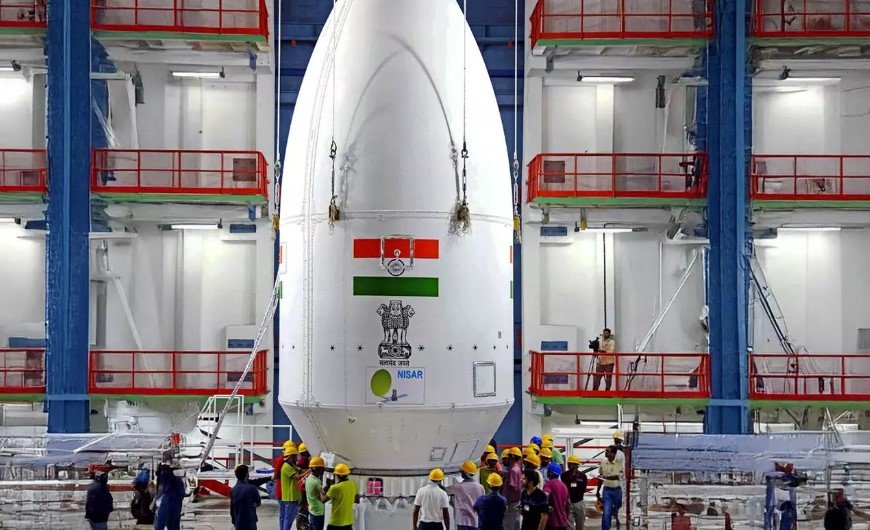GSLV-F16 to carry joint NASA-ISRO satellite into orbit today; pandemic-era project now a symbol of global cooperation
In a few hours, a space collaboration nearly a decade in the making will finally lift off. At exactly 5:40 p.m. today, ISRO’s GSLV-F16 is scheduled to launch from Sriharikota carrying a truly special payload: the NISAR satellite.
This one’s more than just another science mission. It’s a shared leap into Earth observation, built by India and the United States — thousands of miles apart and during the peak of a global crisis.
The Technical Specs Are Impressive, But the Backstory is Better
Weighing 2,392 kilograms, NISAR (short for NASA-ISRO Synthetic Aperture Radar) is headed for a 743-kilometre-high sun-synchronous orbit. That’s a mouthful, but in plain speak: it’ll orbit the Earth at the same local solar time on each pass, capturing data consistently.
The satellite carries dual-frequency radars — L-band from NASA and S-band from ISRO — designed to map everything from forest biomass to ice-sheet shifts. And it’ll do this with millimetre precision.
But here’s the kicker: this bird was assembled on opposite ends of the Earth, across time zones, cultures, and a once-in-a-century pandemic. NASA’s Jet Propulsion Lab built its half in California. ISRO handled the rest in Bengaluru.
“It was brutally tough,” said one senior NASA official who worked on the integration. “Shipping hardware during COVID, coordinating over Zoom, dealing with component shortages… but we got through it. And honestly? It brought us closer.”

A Bit of History and a Whole Lot of Trust
NASA and ISRO first inked the NISAR agreement back in 2014. At the time, it was seen as symbolic — a handshake between space agencies. Few thought the timeline would stick. And it didn’t. Pandemic delays, funding hold-ups, and tricky testing pushed the date back.
Still, both sides kept at it.
What makes NISAR unique isn’t just its radar — it’s how seamlessly the roles were split. NASA handled the main payload, ISRO took charge of the satellite bus and launch. That kind of division demands serious trust. And apparently, they found it.
Dr. S. Somanath, ISRO’s chairman, called it “a model for future missions.” He added: “We didn’t just share tasks. We shared responsibility.”
Why This Satellite Actually Matters
Alright, let’s get to the why.
NISAR isn’t some deep-space telescope. It’s aimed squarely at Earth. Its job is to scan the planet every 12 days and track:
-
Land subsidence in cities
-
Melting glaciers in the Himalayas
-
Carbon stock in dense forests
-
Earthquakes and tectonic shifts
All in near real-time. And all from a bird’s-eye view.
That matters in a world grappling with climate change, natural disasters, and fast-paced urbanisation. India’s Ministry of Earth Sciences says it plans to use NISAR data to monitor Himalayan rivers and early flood warnings.
Meanwhile, US agencies will rely on the data to map coastal erosion and wildfire risks.
And here’s the real kicker — all the data will be free. Yep, open access.
The Launch Sequence and What to Expect
Launch is scheduled for 5:40 p.m. IST from the Satish Dhawan Space Centre in Sriharikota. GSLV-F16 will take approximately 19 minutes to place NISAR into its sun-synchronous orbit.
Let’s break that down real quick:
| Phase | Approx Time After Launch | Key Action |
|---|---|---|
| Lift-off | 0:00 mins | GSLV-F16 ignites and lifts off |
| Stage separation | ~4:40 mins | First stage separates |
| Cryogenic ignition | ~5:00 mins | Upper stage ignition begins |
| Orbit insertion | ~19:00 mins | NISAR released into 743-km orbit |
ISRO will stream the launch live on its YouTube and X handles. Crowds have already begun gathering at the public viewing gallery, reopened earlier this year after COVID-era closures.
Symbolism Runs Deeper Than Science
You could say today’s launch is about satellites and radar. But that’d be only half the story.
What’s really on display is a rare moment of trust between two democracies that often find themselves at geopolitical odds. With US-China tensions high and India asserting itself more on the global stage, NISAR sends a different kind of signal.
NASA Administrator Bill Nelson, who visited Bengaluru earlier this year, said it best: “This is what science diplomacy looks like.”
And there’s emotion too. One ISRO engineer, who worked on the payload bay, said: “We’d wake up at 2 a.m. for calls with California. Sometimes I’d just mute myself and listen to their dogs barking in the background. Now, I’ll watch this thing launch and say — yep, we built that.”
